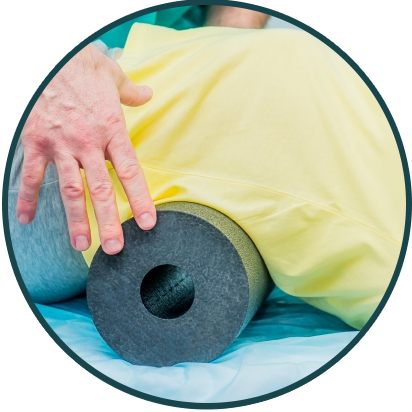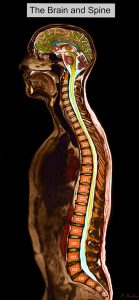Scoliosis and Kyphosis
Understand Your Condition
Scoliosis & Kyphosis: Common Spinal Conditions
Scoliosis and kyphosis are common spinal conditions that many people may have. Mild cases often go unnoticed or only require minor treatment. However, those with moderate to severe cases may require more aggressive treatment and even surgery. Both conditions can cause back pain, alignment and posture issues, and other more serious issues if left untreated.
If you or a loved one in your care have scoliosis or kyphosis, schedule a virtual spinal consultation with Dr. Ra’Kerry Rahman to begin your treatment.

Symptoms of Scoliosis
Symptoms of Scoliosis
- Uneven shoulders or hips
- Prominent rib cage
- Torso tilt
- Prominent rib cage and/or shoulder blade
- Legs of uneven length
- Lower back pain
- Shooting pain in legs
Symptoms of Kyphosis
- Difference in shoulder height
- Head bends forward
- Uneven shoulder blade height or position
- Height of upper back appears higher than normal
- Tight hamstrings
- Back pain
Scoliosis and Kyphosis

A typical spine, showing the spine's natural curves
Scoliosis and Kyphosis
Our spines curve naturally. If you look at yourself in the mirror from the side, you’ll see that your neck (the cervical spine) curves slightly inwards, your mid back (the thoracic spine) curves outwards, and your low back (the lumbar spine) curves inwards. If you look at your spine from the front or the back, it should appear straight.
Do I Have Scoliosis or Kyphosis?
Sometimes, the natural curves in our spines become bigger or smaller than they should be, or the curves may even start to curve in the wrong direction. These different types of curves cause spinal deformities. If your spine curves from side to side, this is called scoliosis. If thoracic spine begins to curve excessively outwards (giving a hunchback appearance) this is called kyphosis, while an excessive inward curve in the neck or lumbar spine is known as hyper-lordosis.
Do I Need Surgery?
Spinal deformities are often mild, and often do not require surgery. In fact, many people have mild spinal deformities, and their friends and family are not even aware of them. However, some deformities do progress to a stage where they need to be corrected by surgery. The good news is that in the last 35 years there have been incredible advances in spinal deformity surgery. Today, surgeons like Dr. Rahman, can correct spinal deformities far better, and with less pain and shorter recovery times, than we’d dreamt possible just a few years ago.
Learn More
Keep reading to learn more or browse our library of videos. If you have questions about your own condition, request an appointment or contact us! Our Library of Videos: Browse Here >
Scoliosis
According to a recent study, about 6 million people in the United States have scoliosis — meaning that 2-3% of the population, including children, adolescents, and adults have this condition. To put it another way, scoliosis and other spinal deformities are common and many go unnoticed for years or for the entirety of a patient's life. For many people, therapeutic means of treatment are all a person will need to live comfortably. However, for children and teens, those with more severe scoliosis, and patients with Adult Degenerative Scoliosis, it's important to seek treatment.
Juvenile Scoliosis
Usually, juvenile scoliosis is detected in children who are 10-12 years old as they may exhibit uneven shoulders, prominent ribs, an uneven waistline or other symptoms. The most common type of scoliosis found in children is idiopathic scoliosis. There is no known cause of scoliosis — children can’t develop it from heavy backpacks so there is no way at this time to prevent it. It may be related to genetics, and it can be caused by other conditions such as cerebral palsy and muscular dystrophy.
Only some children need treatment but it is important that the condition is monitored by a doctor. If moderate to severe cases of scoliosis are left untreated, the curvature of the spine will worsen and could cause deformity, back pain, and difficulty breathing due to the rib cage pressing against the heart and lungs.
Learn more about pediatric scoliosis, treatment options, and more, and request an appointment with Dr. Ra’Kerry Rahman, Houston’s Top Rated Local® back surgeon and back pain specialist.
Adolescent Idiopathic Scoliosis (AIS)
Adolescent Idiopathic Scoliosis (AIS) is usually diagnosed when patients are 10-18 years old with 70% of patients being girls. Like other forms of scoliosis, symptoms will include uneven hips and/or shoulders, one prominent rib, an uneven waist, and other symptoms. AIS isn’t usually painful but moderate to severe cases of AIS can worsen due to growth spurts, create deformities, and become painful.
If you think your child has AIS, it is important to seek medical counsel to understand what the best means of treatment may be to prevent the condition from worsening. In minor cases, it is unlikely that the curve will create serious problems, and sometimes treatment is unneeded. For moderate to severe cases, bracing and/or surgery may be required.
Learn more about AIS and request an appointment with Dr. Rahman today.
Adult Scoliosis
Scoliosis can also occur in adults as well, due to degenerative diseases, adolescent idiopathic scoliosis that was not caught, and other conditions. Most adults who have scoliosis rarely need surgery or treatment. However, often a back pain specialist can prescribe treatments that can enhance a patient’s quality of life. Such treatments can include exercise, soft-tissue therapy, and massage.
Symptoms of scoliosis include back pain, shooting pain, uneven shoulders or hips, torso tilt, uneven leg length, and more. To diagnose, the doctor will ask the patient to perform range-of motion tests and will test reflexes and balance. X-rays will also most likely be ordered and a myelogram may be ordered if they believe there may be neurological damage.
Learn more about adult scoliosis and contact us or make an appointment with Houston's Top Rated Local back pain specialist and back surgeon, Dr. Rahman.
Kyphosis
Kyphosis is similar to scoliosis as it is a deformity in the spine. However, unlike scoliosis which is a spine deformity that curves to either side, kyphosis curves from front to back. Hyperkyphosis is when the thoracic spine curves greater than 40 degrees.
Kyphosis can be congenital, developmental, or caused by trauma. Usually, patients with kyphosis experience little to no back pain and many patients simply notice a visual deformity in their back. Like scoliosis, a diagnosis is often found through visual examination and x-rays. The doctor may also order an MRI to check the soft tissue around the spine for abnormalities.
Surgery is sometimes needed for severe cases. However, often non-surgical treatment can help patients find better posture.
Request an appointment at our Houston spinal institute with Dr. Rahman.
